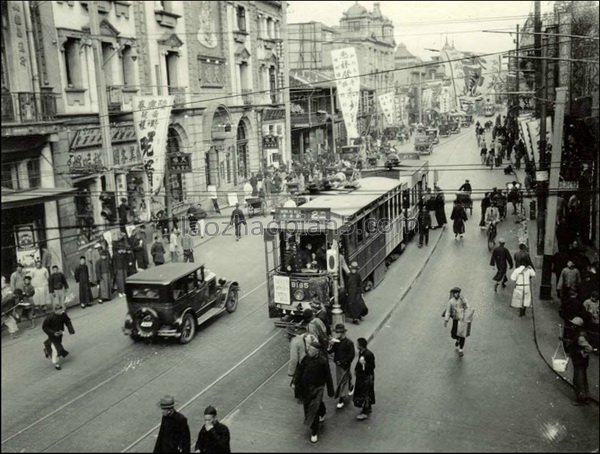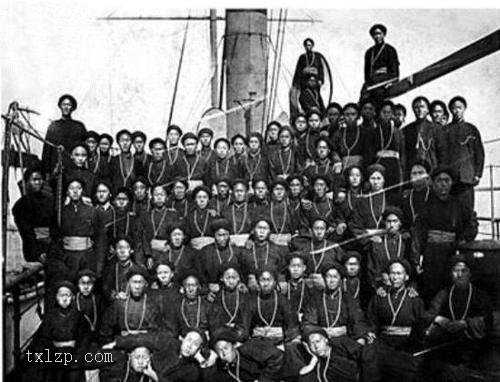Period:Unknown Production date:6thC-7thC
Materials:stucco, 灰泥 (Chinese),
Technique:mould-made, appliqué, 模製 (Chinese), 應用的 (Chinese),
Subjects:deity 神 (Chinese)
Dimensions:Height: 31.50 centimetres
Description:
Fragmentary stucco figure of a male deity, probably a Bodhisattva. The figure has a serene facial expression and hair which is drawn loosely back under a fillet made of alternating plain and beaded bands. The topknot of the hairstyle is broken off. He wears an armlet with a flower-shaped decoration on the right upper arm and two beaded bands around the chest. These are decorated with a rosette in the centre. Behind the figure, the remains of a cloak are visible. While the body was made using a mould, the jewellery was moulded and applied separately.
IMG
![图片[1]-figure; 畫像(Chinese) BM-MAS.1011-China Archive](https://chinaarchive.net/Unknown/43/mid_00013057_001.jpg)
Comments:EnglishFrom Whitfield 1985:This pair of devatas are among the most complete of the hundreds of figures found by Stein in the cella of a ruined temple at Ming-oi, not far from the one containing the wall paintings of the preceding plate. Stein dated them and most of the other stuccos from the site to the eighth century, on the basis of coins placed near the images, which were dated to the Dali (A.D. 766-79) and Jianzhong (A.D. 780-83) reigns (Serindia, Vol. Ⅲ, p. 1194). In the museum’s own display, they were dated even later, as eighth-to tenth-century pieces. Had it not been for the presence of these coins, Stein would have dated the images considerably earlier, but he felt that the numismatic evidence was conclusive and that the earlier style of the figures could be sufficiently accounted for by the discovery of moulds, which could have continued in use for centuries. As we have just seen in Pl. 95, there is no doubt that the Ming-oi site, with its extensive group of temples, was still in use in the Uighur period, since the costumes of the donors from the wall paintings are unmistakable. But the use of wall paintings as the principal decoration in this temple suggests that there had been a shift away from moulded stucco decorations, as the two media are not easily combined. Besides, coins could have been deposited by worshippers for as long as the temple remained accessible, and while the roofs of the shrines remained intact. Even after the collapse of the roofs, many unfired figures survived with their colouring until the present time. These considerations may allow us to establish the date of the figures according to their style, which is still close to the art of Gandhara. A later style. Showing Chinese influence, can also be identified in the stucco figures of some of the shrines, such as the Bodhisattva head of Pl. 102. In composition too, to judge by the sheer numbers of figures and the way that they were closely packed together (some groups still in situ are illustrated in photographs taken by Oldenburg, 1914, Pls. Ⅲ-Ⅴ), the relief decoration of the Ming-oi temples must have been comparable to that of Gandhara. Plate 96 shows some of these features in a single devata. Moulding was used extensively to give such figures their perfection of expression, with smooth and regular features, and for the appliqué scarves and ornaments. The devata is broken off at the knees, but Fig. 140 allows us to see the proportions of the long and slender legs of a similar piece. All are built up of layers of clay applied to a core of reeds bound in a bundle, over which the moulded form fitted as a final layer. Fire has destroyed the reed core, leaving only the impression of this and its binding, and has totally removed the original colouring, but at the same time it has hardened the clay and ensured its survival. The scarf around the shoulders frames the figure and masks the join to the wall, as with the next figure. Changes in attitude were probably made by adjusting the still-moist impression as taken from the mould, as was certainly done with many of the small heads shown in Pls. 104-9. Some actual moulds for small parts of figures are in the Stein Collection. One, Mi. iv. 001 (Fig. 148), is for casting a small single seated figure of the Buddha, two curls of hair, and two zig-zag locks (Serindia, Vol. Ⅳ, Pl. CXXXVII). Far more spectacular are the moulds made for the whole upper body and head of comparatively large figures, which are among the finds made by Oldenburg at Kucha and are now displayed in the Hermitage Museum, Leningrad. More than thirty moulds were found at Ming-oi by Grunwedel and Le Coq (Grunwedel, 1912, p. 192). These moulds, like the one just referred to in the Stein Collection, are of plaster of Paris. ChineseFrom Whitfield 1985:斯坦因於明屋遺址發現上圖壁畫的寺的附近的一個寺址中的室裏發現數百塑像,這兩身天部像是其中破損最輕的兩件。斯坦因把同一遺迹的大致相同的這些泥像都斷爲8世紀。那是因爲離像不遠的地方發現了大曆(766~779年)和建中(780~783年)的貨幣(參照《西域》卷3,1194頁)。而在大英博物館的展品說明中,把它們的年代往後推至8~10世紀。如果沒有貨幣,斯坦因大概還會認爲這些像的年代更早,貨幣成了決定性的作用。有關這些像延襲了早期表現風格這點,數百年延續使用下來的模型的發現,可作充分說明。正如圖95所示,明屋遺址以及許多寺院群無疑在回鶻時期仍然使用,根據壁畫上供養人的衣裳就能一目了然。但壁畫作爲該佛寺的主要裝飾而存在,顯示了由泥塑造像向壁畫图樣的轉變。因爲把兩者融洽地組合,是件不容易的事情。另外,貨幣遺物可能是塑造泥像沒遭破壞寺院仍然運轉時信徒們捐獻的香資。特別是屋脊沒有損壞而完整保留下來的寺中,即使倒塌了但沒有失火,塑像直到現在還完全保留著色彩。綜合以上考慮,這些像的年代,以風格極接近犍陀羅美術作爲最主要根據來判斷更合適。時代越往後,越能見到中國的影響,如圖102的菩薩頭部等及若干寺院的泥像。結構上,其實由衆多像構成以及它們的組成方式(奧登堡在遺迹現場拍攝的若干圖的照片已收錄於他1914年的報告裏)等方面,這些明屋遺迹的身雕裝飾可與犍陀羅身雕裝飾進行比較。圖96中展示了具備那幾處特點的天部像。連細部都廣泛使用模子,産生出光滑有規則的表現。再者,天衣和裝飾物等粘貼的裝飾也用模子。此像膝蓋以下已缺損,但從Fig. 140我們可以推測出此像的比例。這些像是在捆緊的槁草芯上反復塗上塑土,其上再安裝用模子製作的外形造型。經過火災,槁草的芯燃盡,只剩形狀和捆綁的繩子痕迹,色彩也比當初有變化,但經過燃燒塑土變得很堅硬,耐保存。披在兩肩上的天衣,像畫框一樣圍著塑像,遮蓋了鄰像和牆壁間的接合部。姿勢和表情的變化,可能是從模子裏取出以後,在半乾狀態下調整的,從圖104~109中展示的若干小像頭部可以窺出其究竟。斯坦因的收集品中,包括很多實際製作這些像細部使用的模子,有一個小佛坐像的模子(Mi.iv.001)、兩個卷髮的模子、兩個穗狀頭髮的模子(參照《西域》,卷4,圖版CXXXVII)等。另外,奧登堡在庫車收集到的遺物中,有製作大型像上半身和頭部使用的大模子,現陳列于艾爾米塔什美術館。格倫威德爾和勒柯克在明屋發現的模子也有30多個(參照“Grunwedel”, 1912,192頁)。在巴黎的石膏模子與現在所談的斯坦因收集品中的模子相同。
Materials:stucco, 灰泥 (Chinese),
Technique:mould-made, appliqué, 模製 (Chinese), 應用的 (Chinese),
Subjects:deity 神 (Chinese)
Dimensions:Height: 31.50 centimetres
Description:
Fragmentary stucco figure of a male deity, probably a Bodhisattva. The figure has a serene facial expression and hair which is drawn loosely back under a fillet made of alternating plain and beaded bands. The topknot of the hairstyle is broken off. He wears an armlet with a flower-shaped decoration on the right upper arm and two beaded bands around the chest. These are decorated with a rosette in the centre. Behind the figure, the remains of a cloak are visible. While the body was made using a mould, the jewellery was moulded and applied separately.
IMG
![图片[1]-figure; 畫像(Chinese) BM-MAS.1011-China Archive](https://chinaarchive.net/Unknown/43/mid_00013057_001.jpg)
Comments:EnglishFrom Whitfield 1985:This pair of devatas are among the most complete of the hundreds of figures found by Stein in the cella of a ruined temple at Ming-oi, not far from the one containing the wall paintings of the preceding plate. Stein dated them and most of the other stuccos from the site to the eighth century, on the basis of coins placed near the images, which were dated to the Dali (A.D. 766-79) and Jianzhong (A.D. 780-83) reigns (Serindia, Vol. Ⅲ, p. 1194). In the museum’s own display, they were dated even later, as eighth-to tenth-century pieces. Had it not been for the presence of these coins, Stein would have dated the images considerably earlier, but he felt that the numismatic evidence was conclusive and that the earlier style of the figures could be sufficiently accounted for by the discovery of moulds, which could have continued in use for centuries. As we have just seen in Pl. 95, there is no doubt that the Ming-oi site, with its extensive group of temples, was still in use in the Uighur period, since the costumes of the donors from the wall paintings are unmistakable. But the use of wall paintings as the principal decoration in this temple suggests that there had been a shift away from moulded stucco decorations, as the two media are not easily combined. Besides, coins could have been deposited by worshippers for as long as the temple remained accessible, and while the roofs of the shrines remained intact. Even after the collapse of the roofs, many unfired figures survived with their colouring until the present time. These considerations may allow us to establish the date of the figures according to their style, which is still close to the art of Gandhara. A later style. Showing Chinese influence, can also be identified in the stucco figures of some of the shrines, such as the Bodhisattva head of Pl. 102. In composition too, to judge by the sheer numbers of figures and the way that they were closely packed together (some groups still in situ are illustrated in photographs taken by Oldenburg, 1914, Pls. Ⅲ-Ⅴ), the relief decoration of the Ming-oi temples must have been comparable to that of Gandhara. Plate 96 shows some of these features in a single devata. Moulding was used extensively to give such figures their perfection of expression, with smooth and regular features, and for the appliqué scarves and ornaments. The devata is broken off at the knees, but Fig. 140 allows us to see the proportions of the long and slender legs of a similar piece. All are built up of layers of clay applied to a core of reeds bound in a bundle, over which the moulded form fitted as a final layer. Fire has destroyed the reed core, leaving only the impression of this and its binding, and has totally removed the original colouring, but at the same time it has hardened the clay and ensured its survival. The scarf around the shoulders frames the figure and masks the join to the wall, as with the next figure. Changes in attitude were probably made by adjusting the still-moist impression as taken from the mould, as was certainly done with many of the small heads shown in Pls. 104-9. Some actual moulds for small parts of figures are in the Stein Collection. One, Mi. iv. 001 (Fig. 148), is for casting a small single seated figure of the Buddha, two curls of hair, and two zig-zag locks (Serindia, Vol. Ⅳ, Pl. CXXXVII). Far more spectacular are the moulds made for the whole upper body and head of comparatively large figures, which are among the finds made by Oldenburg at Kucha and are now displayed in the Hermitage Museum, Leningrad. More than thirty moulds were found at Ming-oi by Grunwedel and Le Coq (Grunwedel, 1912, p. 192). These moulds, like the one just referred to in the Stein Collection, are of plaster of Paris. ChineseFrom Whitfield 1985:斯坦因於明屋遺址發現上圖壁畫的寺的附近的一個寺址中的室裏發現數百塑像,這兩身天部像是其中破損最輕的兩件。斯坦因把同一遺迹的大致相同的這些泥像都斷爲8世紀。那是因爲離像不遠的地方發現了大曆(766~779年)和建中(780~783年)的貨幣(參照《西域》卷3,1194頁)。而在大英博物館的展品說明中,把它們的年代往後推至8~10世紀。如果沒有貨幣,斯坦因大概還會認爲這些像的年代更早,貨幣成了決定性的作用。有關這些像延襲了早期表現風格這點,數百年延續使用下來的模型的發現,可作充分說明。正如圖95所示,明屋遺址以及許多寺院群無疑在回鶻時期仍然使用,根據壁畫上供養人的衣裳就能一目了然。但壁畫作爲該佛寺的主要裝飾而存在,顯示了由泥塑造像向壁畫图樣的轉變。因爲把兩者融洽地組合,是件不容易的事情。另外,貨幣遺物可能是塑造泥像沒遭破壞寺院仍然運轉時信徒們捐獻的香資。特別是屋脊沒有損壞而完整保留下來的寺中,即使倒塌了但沒有失火,塑像直到現在還完全保留著色彩。綜合以上考慮,這些像的年代,以風格極接近犍陀羅美術作爲最主要根據來判斷更合適。時代越往後,越能見到中國的影響,如圖102的菩薩頭部等及若干寺院的泥像。結構上,其實由衆多像構成以及它們的組成方式(奧登堡在遺迹現場拍攝的若干圖的照片已收錄於他1914年的報告裏)等方面,這些明屋遺迹的身雕裝飾可與犍陀羅身雕裝飾進行比較。圖96中展示了具備那幾處特點的天部像。連細部都廣泛使用模子,産生出光滑有規則的表現。再者,天衣和裝飾物等粘貼的裝飾也用模子。此像膝蓋以下已缺損,但從Fig. 140我們可以推測出此像的比例。這些像是在捆緊的槁草芯上反復塗上塑土,其上再安裝用模子製作的外形造型。經過火災,槁草的芯燃盡,只剩形狀和捆綁的繩子痕迹,色彩也比當初有變化,但經過燃燒塑土變得很堅硬,耐保存。披在兩肩上的天衣,像畫框一樣圍著塑像,遮蓋了鄰像和牆壁間的接合部。姿勢和表情的變化,可能是從模子裏取出以後,在半乾狀態下調整的,從圖104~109中展示的若干小像頭部可以窺出其究竟。斯坦因的收集品中,包括很多實際製作這些像細部使用的模子,有一個小佛坐像的模子(Mi.iv.001)、兩個卷髮的模子、兩個穗狀頭髮的模子(參照《西域》,卷4,圖版CXXXVII)等。另外,奧登堡在庫車收集到的遺物中,有製作大型像上半身和頭部使用的大模子,現陳列于艾爾米塔什美術館。格倫威德爾和勒柯克在明屋發現的模子也有30多個(參照“Grunwedel”, 1912,192頁)。在巴黎的石膏模子與現在所談的斯坦因收集品中的模子相同。
© Copyright
The copyright of the article belongs to the author, please keep the original link for reprinting.
THE END

![[Qing Dynasty] British female painter—Elizabeth Keith, using woodblock prints to record China from the late Qing Dynasty to the early Republic of China—1915-China Archive](https://chinaarchive.net/wp-content/uploads/2022/11/image-191x300.png)



